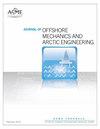Numerical Study on the Automatic Ballast Control of a Floating Dock
IF 2.1
4区 工程技术
Q3 ENGINEERING, MECHANICAL
Journal of Offshore Mechanics and Arctic Engineering-Transactions of the Asme
Pub Date : 2023-11-07
DOI:10.1115/1.4064014
引用次数: 0
Abstract
Abstract The ballast control of a floating dock mainly relies on manual operations, which can be time-consuming and requires skilled workers. This study proposes an automatic ballast control system for floating docks, which improves operational efficiency and safety during the vessel docking process. A numerical model is developed to simulate the dynamic process of the floating dock's operations, which includes a six-degree-of-freedom (6-DOF) model, a hydrostatic force model, a hydrodynamic force model, and a hydraulic model. The hydrostatic force model is developed using the Archimedes law and a strip theory along the longitudinal direction. The hydrodynamic model is made based on the effects of added mass and dynamic damping. The hydraulic model is proposed to deal with the hydraulic calculation of the ballast water system. The present automatic ballast control is designed based on a modified proportional controller (P-controller) to control the valve opening angles when the pitch or roll angles are larger than the corresponding threshold values. Without using controllers, the roll angles of the dock can reach 8.9deg and 13deg during the ballasting and de-ballasting operations, respectively. The present modified P-controller with optimized control parameters can stabilize the dock during the ballasting and de-ballasting operations and keep the maximum pitch and roll angles no larger than 0.016deg and 0.0783deg, respectively. The present automatic control will be further implemented in the vessel docking cases and can significantly improve the stability of the dock.浮船坞自动压载控制的数值研究
摘要浮船坞的压载控制主要依靠人工操作,耗时长,需要熟练的工人。本文提出了一种浮船坞自动压载控制系统,提高了船舶进坞过程的操作效率和安全性。建立了浮船坞作业动力过程的数值模拟模型,包括六自由度模型、静水力模型、动水力模型和水力模型。利用阿基米德定律和纵向条形理论建立了流体静力模型。根据附加质量和动力阻尼的影响,建立了水动力模型。针对压载水系统的水力计算,提出了相应的水力模型。目前的自动镇流器控制是基于改进的比例控制器(p -控制器)设计的,当俯仰角或横摇角大于相应的阈值时,控制阀的开度角。在不使用控制器的情况下,船坞在压载和卸压时的侧倾角分别可达8.9度和13度。改进的p -控制器通过优化的控制参数,可以使船坞在压载和卸压过程中保持稳定,最大俯仰角和最大横摇角分别不大于0.016°和0.0783°。本文提出的自动控制方法将进一步应用于船舶靠泊中,可以显著提高船坞的稳定性。
本文章由计算机程序翻译,如有差异,请以英文原文为准。
求助全文
约1分钟内获得全文
求助全文
来源期刊
CiteScore
4.20
自引率
6.20%
发文量
63
审稿时长
6-12 weeks
期刊介绍:
The Journal of Offshore Mechanics and Arctic Engineering is an international resource for original peer-reviewed research that advances the state of knowledge on all aspects of analysis, design, and technology development in ocean, offshore, arctic, and related fields. Its main goals are to provide a forum for timely and in-depth exchanges of scientific and technical information among researchers and engineers. It emphasizes fundamental research and development studies as well as review articles that offer either retrospective perspectives on well-established topics or exposures to innovative or novel developments. Case histories are not encouraged. The journal also documents significant developments in related fields and major accomplishments of renowned scientists by programming themed issues to record such events.
Scope: Offshore Mechanics, Drilling Technology, Fixed and Floating Production Systems; Ocean Engineering, Hydrodynamics, and Ship Motions; Ocean Climate Statistics, Storms, Extremes, and Hurricanes; Structural Mechanics; Safety, Reliability, Risk Assessment, and Uncertainty Quantification; Riser Mechanics, Cable and Mooring Dynamics, Pipeline and Subsea Technology; Materials Engineering, Fatigue, Fracture, Welding Technology, Non-destructive Testing, Inspection Technologies, Corrosion Protection and Control; Fluid-structure Interaction, Computational Fluid Dynamics, Flow and Vortex-Induced Vibrations; Marine and Offshore Geotechnics, Soil Mechanics, Soil-pipeline Interaction; Ocean Renewable Energy; Ocean Space Utilization and Aquaculture Engineering; Petroleum Technology; Polar and Arctic Science and Technology, Ice Mechanics, Arctic Drilling and Exploration, Arctic Structures, Ice-structure and Ship Interaction, Permafrost Engineering, Arctic and Thermal Design.

 求助内容:
求助内容: 应助结果提醒方式:
应助结果提醒方式:


